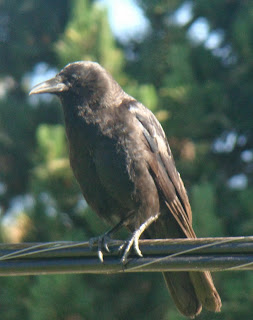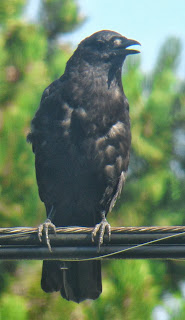Primary
feathers from left and right wings, thinner on the fore-edge.
Erosion
is evident on both edges.
From July on, the crows are in moult, even the ones that hatched out in the summer. The feathers that grew in beginning last July work their way out, and new feathers grow. There is a period of more than two months when crows lose their glossy black and become not just a drab brown, but because of the feathers coming out and the feathers coming in, they look like a medieval band of lepers. This is when you see bits of their insulating undercoat made up of little fluffy grey feathers.
Crow at the worst stage of moult.
Air -- and sunlight -- erodes feathers. The brilliant black that sometimes flashes blue and purple in the right angle of light is a matter of refraction, not only of melanins. During the year the structure of the feathers that refracts the gloss wears down, and at the end of summer crows show the underlying pigments.
Not all of our crows are evenly-pigmented. The Korax family has patches of lighter-colored feathers all year around, some of them with a light ring around the neck. They are not discriminated against by the black crows.
Not all of our crows are evenly-pigmented. The Korax family has patches of lighter-colored feathers all year around, some of them with a light ring around the neck. They are not discriminated against by the black crows.
The fore-edges of the wings gradually deteriorate. Brushing against the nest, or tree branches and telephone poles, or other crows, wears down feathers. If you want to see nearly perfect feathers, go to this site created by the US Fish and Wildlife Service where you can identify most of the individual feathers from 100+ species of birds.






No comments:
Post a Comment
I will not publish Anonymous comments.